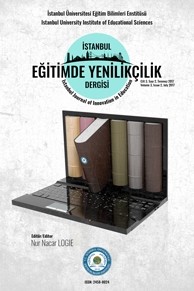ISO 9126 Değerlendirme Modeli’nin Adapt Framework’e Uygulanması
Bu çalışmada “Mobil Öğrenme Kapsamında 2D ve 3D Destekli Görsel ve İşitsel Teknikler Kullanılarak Tablet, Etkileşimli Tahta ve Mobil İletişim Araçlarına yönelik Ortaöğretim 9. Sınıf Türk Dili ve Edebiyatı ders içeriklerinin Z-Kitap Formatında Oluşturulması” adlı projemizin üçüncü safhasını oluşturan, ve diğer iki makalemizde yayınlanan içeriklerin e-öğrenme platformuna uygulamasını sağlamak üzere kullandığımız açık kaynak kodlu Adapt Framework adlı e-öğrenme içerik hazırlama aracı’nın ISO 9126 standartlarına göre değerlendirmesi yapılacaktır.
Anahtar Kelimeler:
e-öğrenme, Adapt Framework, ISO 9126
-
In the scope of this study, as an e-learning content authoring tool, Adapt Framework was examined according to the evaluation model ISO 9126. More precisely, as a result of the assessment of the 3rd phase of our Project, “Content creation of 9th gade Turkish Litterature course within the scope of mobile learning by audio-visuel 2D- 3D techniques on mobie devices” supported by The Department Of Scientific Research Projects of İstanbul University, some e-learning contents were prepared and implemented to the above-mentioned tool.
Keywords:
e-learning, Adapt Framework, ISO 9126,
___
- Bevan, N. (1999). Quality in Use: Meeting User Needs for Quality. Journal of System and Software. 49,1. Ss. 89-96.
- Chua, B. B. & Dyson, L. E. (2004). Applaying the ISO 9126 model to the evaluation of an e-learning system, Ascillite, 1-8. Çevirimiçi: http://www.ascilite.org.au/ conferences/perth04/procs/chua.html (05.05.2015 tarihinde erişilmiştir).
- Çifçili, V., Sertelin Mercan, Ç., Emir, S. & Kahveci, N.G. (2012). (Fatih) Projesi Pilot Uygulama Değerlendirmesi (Basılmamış Rapor), ss.86-112
- Kayaduman, H., Sırkaya, M. & Seferioğlu, S. S. (2011). Eğitimde FATİH Projesinin Öğretmelerin Yeterlik Durumları Açısından İncelenmesi, Akademik Bilişim, 2-13.
- Solemon, B. & Sulaiman, R. (2006). Rapid E-Learning Content Management Systems (RE-COMS), International Journal of Computing & Information Services, 4(1), 1-8. Çevirimiçi: http://www.ijcis.info/international%20journal%20of%20computing%20and%20information%20sciences_files/vol4n1_ebel/pp%2001%20-%2008.pdf (19.11.2015 tarihinde erişilmiştir.)
- Squire D, Preece J (1996) Usability and learning: evaluating the potential of educational software. Comput Educ 27 (1):15-22)
- İbili, E., Bayram F., Hakkari, F., Kantar, M. & Doğan, M. (2009). SCORM Uyumlu Eğitim Yönetim Sisteminin Tasarlanması ve Üniversite Bazında Uygulanması, Akademik Bilişim’09 - XI. Akademik Bilişim Konferansı Bildirileri 11-13 Şubat 2009 Harran Üniversitesi, Şanlıurfa, ss. 277-286.
- Juran, J. M. (1988). Juran on planning for quality. New York: Free Press.
- Van zeıst, R.H. & Hendriks, P. R. H. (1996). Specifying software quality with the extended ISO model. Software Quality Journal. 5, ss. 273-284.
- Valenti, s. Cucchiarelli, A. & Panti, M. (2002). Computer Bases Assessment Systems Evaluation via the ISO 9126 Quality Model. Journal of Information Technology Education, 1(3), 57-175.
- Çevirimiçi: http://www.imsglobal.org/background.html (05.05.2015 tarihinde erişilmiştir.)
- Çevirimiçi:http://ieeexplore.ieee.org/servlet/opac?punumber=8897 DOI:10.1109/IEEESTD.2003.94410 (05.05.2015 tarihinde erişilmiştir.)
- ISSN: 2458-8024
- Başlangıç: 2015
- Yayıncı: İstanbul Üniversitesi
Sayıdaki Diğer Makaleler
Enhanced IMS Metadata for Surgical Education Simulators
Nergiz Ercil ÇAĞILTAY, İbrahim CERECİ
Akademik Başarı ile Okul İklimi Arasındaki İlişki
Ümit BAHÇETEPE, Filiz MEŞECİ GİORGETTİ
ISO 9126 Değerlendirme Modeli’nin Adapt Framework’e Uygulanması
Alaskar ÖZPERÇİN, Nazlı CİHAN, Nur NACAR-LOGİE, Vakur ÇİFTÇİLİ
Eğitsel Devinim Araştırmalarında Devinimsel Alan Kavramının Gözden Geçirilmesi
Assessing E-learning Readiness of Instructors in Turkey
Sushil.K SHARMA, Sevinç GÜLSEÇEN, Zeki ÖZEN, Elif KARTAL
Zeliha Özsoy GÜNEŞ, Fatma Gülay KIRBAŞLAR
Araştırma ve Öğretimde Paralel Derlem Kullanımı: Uppsala Üniversitesi Örneği
Parental conflict and its association with sibling relationships
